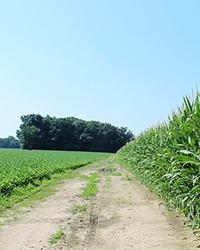A Prognostic Fertilization and Irrigation Module Design for Modeling Bioenergy Crop Agriculture in the Earth System
Modeling agriculture within the Earth system is important not only to predict crop yields and assess food security but also to better understand the intertwined and complex processes in the climate-water-land nexus. Among other factors, efficiently using improved fertilizing techniques by dynamically determining fertilization timing and rates will have large impacts on crop yields.
The researchers found that fertilizers, which in the models are applied spatially uniformly with fixed amounts and timing without considering crop fertilizer demands, lead to a large bias in crop yield simulations. To address this weakness, likely present in most current-generation Earth System Models (ESMs), the team proposed a prognostic fertilization scheme in the model that dynamically determines the timing and rate of each fertilizer application, with the annual amounts and valid fertilization time-windows governed by census data.
The DOE scientists at Pacific Northwest National Laboratory applied the Community Land Model (CLM4.5) at a 0.125 degree resolution to provide the first, county-scale model validation used to simulate crop yields over the Conterminous United States. They found a large bias in simulating crop yields against the U.S. Department of Agriculture (USDA) census data, with a county-level, root-mean-square error (RMSE) of 42% and 38% for simulated U.S. mean corn and soybean (popular biofuel feedstocks) yields, respectively. The researchers then synthesized crop yield, irrigation, and fertilization datasets from the USDA and U.S. Geological Survey to constrain model simulations. Compared with fertilization, they found that irrigation has limited effects on crop yields with improvements limited to irrigated regions. In most current-generation ESMs, fertilizers are applied spatially uniformly with fixed amounts and timing without considering the specific crop fertilizer demand. To address this weakness in the model, the team proposed a prognostic fertilization calculation that dynamically determines the timing and rate of each fertilizer application, with the annual amounts and valid fertilization time-windows informed by existing census data. The optimized fertilization parameterization reduces the RMSE to 22% and 21% for the U.S. mean corn and soybean yields, respectively. Compared with the default CLM4.5, the team’s representation of fertilization substantially improved crop yield simulations, especially over major crop growing regions.


